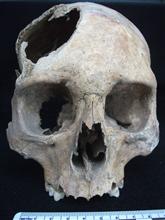Niamh Carty
Niamh Carty
Niamh Carty (PhD Candidate)
The place of violence in Medieval Ireland: Osteological evidence for interpersonal trauma in Irish Medieval assemblages
Supervisor: Dr. Barra Ó Donnabháin
Biological Anthropology and Bioarchaeology Research Group
E-mail: niamh886@gmail.com
I am a third year PhD researcher at the Department of Archaeology at University College Cork. I graduated from Trinity College Dublin in 2006 with a BA (Hons.) in History and have postgraduate qualifications from both the National University of Ireland, Galway (PDip in Archaeology 2007) and University College Cork (MA in Human Osteoarchaeology 2008). My research interests include violence and warfare in the archaeological record and the mortuary practices surrounding those who were killed violently. I have worked on excavations all across Ireland, from prehistoric cremation cemeteries to post-medieval sites and I have excavated in Belgium and I have analysed osteological remains from numerous large and small skeletal assemblages from medieval Ireland. I am also currently involved as an osteological supervisor in the Moqi Project in Southern Peru which is an IFR (Institute of Field Research) Field School run in conjunction with UCLA and USB. I am a member of various professional organizations; the Irish Association of Professional Osteologists (IAPO), the British Association for Biological Anthropology and Osteology (BABAO); the Paleopathology Association (PPA), the Association of Environmental Archaeology, the Meath Archaeological and Historical Society and the Kildare Archaeological Society (KAS).
| Overview |
This project entails an examination of traumatic injuries resulting from violence, namely sharp and blunt force trauma, in 51 Irish skeletal assemblages from both the early and late medieval period. These data will be compared across the assemblages to establish whether patterns of violence are visible in the skeletal material from medieval Ireland. This will be the first time that these types of data will have been collated from across Ireland and analysed in a comparative manner.
The current historiography about warfare in early and late medieval Ireland concludes that pre-Norman warfare was characterised by outbreaks of small-scale localised conflict. The Anglo-Norman invasion is viewed as a watershed in terms of the scale of warfare and that the subsequent late medieval period was characterised by larger scale conflicts. This narrative will be tested using the osteological information to see if there is a change in the frequency, pattern and type of trauma encountered across these periods.
This study will also include an examination of various other parameters that relate to the evidence for interpersonal violence including: the historical background to medieval warfare and violence, both interpersonal and state-mediated, the type of burial allowed to those who were killed violently, types of medieval weaponry (Halpin 2008 and Harbison 1976) that may have caused these interpersonal traumatic injuries in Ireland, and any evidence for treatment of traumatic injuries.
One of the main aims of this research is, for the first time, to bring together osteological data from a number of medieval sites in Ireland relating specifically to trauma resulting from interpersonal violence, and to use these data to ascertain patterns of this type of trauma across Medieval Ireland. This will be achieved through the analysis of a number of roughly contemporary collections from across Ireland and comparing the rates of trauma encountered to discover patterns in prevalence, distribution and form. Secondly, various other factors (such as mortuary practices and the weapons that may have caused these injuries) that are directly related to the osteological data shall be examined to place the osteological data firmly in their appropriate context. This will be accomplished by examining the broader archaeological contexts of individuals, including the manner in which those who were killed violently were buried, and also an in-depth analysis of the morphology of the injuries to attempt to match them to known weapons from the medieval period. Thirdly, when the osteological data have been collated, these can be added to the corpus of literature concerning life in Medieval Ireland (specifically relating to warfare and violence). This will be achieved with a thorough literature review of both primary and secondary sources relating to warfare and violence in Medieval Ireland and correlating this information with the biological data.
By adopting this interdisciplinary approach, a fuller picture of violence and trauma in medieval Ireland can be created and the osteological data can be situated within the appropriate archaeological and historical contexts. This will add a new level to our understanding of the medieval period in Ireland and also to complement existing historiography of the period.
This PhD is funded by both the Irish Research Council (IRCHSS) and Kildare Archaeological Society.
| Overview |
CACSSS (College of Arts, Celtic Studies and Social Sciences) Postgraduate Conference 13th November 2011 – ‘The Place of Violence in Medieval Meath: Osteological Evidence for Interpersonal Trauma in Irish Skeletal Assemblages’
AYIA (Association of Young Irish Archaeologists), Trinity College Dublin, 9th March 2012: Osteological Evidence for Weapon-Related Trauma in Medieval Meath
Landscapes of Assembly: The Oenach in Early Medieval Ireland Conference, UCC, 25th March 2012: Osteological Evidence for Interpersonal Violence at Assembly Sites
IAI (Institute of Archaeologists of Ireland), Galway, 22nd April 2012: ‘Losing Our Heads’: Osteological Evidence for Decapitation in Medieval Ireland
EMASS (Early Medieval Archaeology Student Symposium), UCL London, 16th May 2012: ‘Losing Our Heads’: Osteological Evidence for Decapitation in Medieval Ireland
Publications
Ríocht na Midhe (Journal of the Meath Archaeological and Historical Society) Forthcoming 2013: Article with Patrick Gleeson - Kingship, violence and Loch Da Gabhor: royal landscapes and the production of authority in early medieval Brega - Accepted for Publication in 2013 issue

